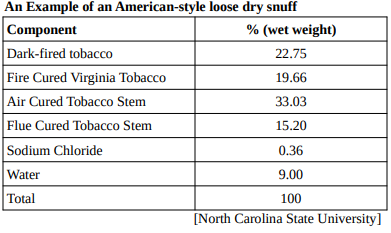Smokeless Tobacco
This broad category of tobacco product includes any oral or nasal tobacco preparation that is used without burning it. The names for them are confusing. Below is a delightful, historical perspective on snuff, snus and dip, provided by squeezyjohn, a member of the Fair Trade Tobacco Forum from Great Britain
At its most basic, nasal snuff is simply fully cured and aged tobacco leaf, pulverized to a fine or coarse dust. A screen can be used to remove any larger bits or pieces. Some have used a burr mill coffee grinder to pulverize the leaf, after stemming it. The variety of leaf used is your choice.
It can be used unflavored (or unscented), or essential oil can be added to modify its character. This is usually dissolved in water or plain alcohol (e.g. vodka), then mixed into the powder. For nasal use, it needs to first be fully dried.

Moist snus is intended for oral use, either loose, or enclosed within a permeable packet.
A recipe for Swedish snus
From jojjas, a member of the Fair Trade Tobacco Forum from Sweden:
- You could use any kind of tobacco leaf you want, even stems could be used (I prefer burley and or Virginia), but they must be very dry or it becomes to heavy to grind them. You could even use unfermented leaves, but only if they are dry.
- Grind tobacco leaf to a fine powder, something between fine sawdust and oatmeal flour. When that is done, add equal weight of tobacco flour with boiling water, with approx 50-70g salt (2-2.75 oz weight). You could use more salt if you prefer.
Example: 0.5kg tobacco you should mix with 0.5 liters water (1 pound tobacco: 1/2 quart of water). - Then mix tobacco and salty water together, so everything is well mixed, and then put it in the plastic container and press it hard with the end of a wooden plank or something similar, to remove excess water. Put on the lid and make sure its tight.
- Place the container in a 90°C (~194°F) oven for 24 hours (Here is where the fermentation occurs.)
- After 24 hours, take out the container and mix the tobacco so there are no lumps.
- Next step is a little bit critical. Do this out side. If its hot direct from oven, it can irritate your eyes and nose when you mix it together.
[Editor’s note: Sodium carbonate is a relatively strong alkali, and will react with iron, aluminum and other metals. The mixing and heating with sodium carbonate should be performed in a non-reactive container—stainless steel, ceramic, glass, a well-enameled pot without interior scratches, or an oven-safe plastic container, in order to avoid dissolving some metal into the snus. The oven temperature is below the boiling point of water.
Sodium carbonate can be made from sodium-bicarbonate—common baking soda (not baking powder) by heating it in the oven at ~ 93° C (200°F) for about an hour.]
- Boil 0.25 liters (1 cup) water with 40-70 g of sodium carbonate, and add to the tobacco. (I prefer 45-50g.) If you want stronger (more nicotine, stronger) snus use, the high dosage. Put it in the plastic container and press it hard with the end of a wooden plank or something similar. Put on the lid, and make sure its tight. Place it in the oven for 12 hours at 90°C (~194°F).
- After 12 hours, take out the snus from the oven, let it cool down, and mix it well so there are no lumps. Now its the time add flavor if you want, and perhaps some substance to keep it moist (glycerin or PPG). Store it in refrigerator to keep it moist and fresh.
*****
A recipe for Swedish snus
From POGreen, a member of the Fair Trade Tobacco Forum from Sweden.
This is how I make 5.5 Ibs of ”Swedish Snus”:
2.2 Ibs tobacco powder (I use a meat grinder to grind my leaves.)
1.75oz to 3.5oz of Salt
1.2 liters or 2.5 pints of water
- Heat the water in a saucepan to lukewarm, take the pan off the burner, and pour the salt into the water to dissolve it by stirring it until the water is clear.
- Have the tobacco powder in a bucket, and pour the lukewarm saltwater over the powder. Mix them with your hands, or a spoon, if it’s too hot. MIX VERY WELL.
- You should have 2 plastic boxes with lids to put the mixed, wet tobacco powder into.
- Take a little at a time. Give the powder a light packing all the way to the top. There should be no holes in the lids.
- Preheat the oven to 194°F.
- Make sure the boxes can take 200°F in the oven. [Microwave-safe food containers should be fine.] Heat for 24 hours.
- Warm 1.5 pints of water in a non-reactive saucepan [stainless, ceramic, glass, or well-enameled] to lukewarm. Take the pan OUTSIDE, then add 1.75 ounces to 3.5 ounces (weight) of sodium carbonate. Dissolve it by stirring until it is clear.
- Remove the box of heated tobacco from the oven. Pour the tobacco into a clean bucket, together with the sodium carbonate solution, and mix it very thoroughly with a spoon.
- Transfer the mixture back into the boxes, and cover it. Return them to the oven at 194° F for another 12 hours.
- Allow the heated boxes to cool with THE LID ON. When it’s cooled to about room temperature, store it in the fridge.
- The longer you keep it in the fridge, the better.
- The sodium carbonate raises the pH (makes it more alkaline), and increases nicotine absorption. For increasing the apparent strength of the snus, consider using a stronger tobacco instead of using too much sodium carbonate, which can irritate the mouth.
- I have used both a Swedish type of Virginia called Alida, together with rustica. Rustica is great for snuff, in my opinion.
*****
A recipe for snus
From Nic, a member of the Fair Trade Tobacco Forum from Finland.
We need:
- An oven
- A meat thermometer to monitor oven temperature
- Roasting bags (that are designed for oven use) and a baking dish to support the bag
- Something to grind the tobacco with, like a meat grinder
- Mixer
- Big bowl or bucket
- Tobacco leaves
Remove the midrib of each leaf. Allow the leaf to dry for a few days at room temperature. You can add some of the midrib, so long as it’s not moldy, to the leaf for grinding. A hand-cranked meat grinder that is connected to a power drill is one way to grind.
Ingredients:
- 100 grams of salt
- 100 grams of sodium carbonate or potash. If you do not have access to this, painting soda or soda ash can be bought from the local hardware store and serves as a good substitute
- 1 kg of tobacco flour.
- 1-1.5 liters of water.
Step 1: Mix the boiling water with salt, stirring until the salt is dissolved. Mix the saltwater with the tobacco flour in a bowl. Stir well until all the tobacco flour is “wet”.
Set the oven at 90°C (~194°F) and let snuff bake in the sealed roasting bag for at least 24 hours.
Step 2: OUTDOORS, mix the sodium carbonate with about 3-5 cups hot water and mix with the baked tobacco flour. Stir well!
Step 3: Bake the snus for 12h in 90°C (~194°F) oven, in a sealed roasting bag.
Step 4: Pack the snus in buckets or boxes and leave cool for about 2 weeks.
An alternative method is to extend the cooking time in step 1, to 3-5 days and skip step 3. This result in a true black and delicious snus but unfortunately this method increases the risk of the snus getting burned. The process requires some monitoring. Flip the roasting bag every day, and make sure it is tightly closed. If you think your snus looks dry after some time in the oven, you can add more water.
Choosing tobacco variety.
The choice of tobacco variety affects the flavor of the end product to some degree. The traditional types used in snus production are Burley, flue-cured, dark air and fire-cured.
- Burley gives a good tobacco taste, and is perfect for making snus. Usually rich in nicotine, a personal favorite!
- Flue-cured usually gives less taste, and contain less nicotine. Suitable to mix with other varieties.
- Dark Air usually contains more nicotine but, according to me, it is less flavorful than the burley.
- Fire-cured varieties provide a strong, smoky flavor, and are perfect as a complement to the other variants.
Twist
Making a twist for chew begins with whole leaf tobacco (variety of your choice, or any blend) in high case, from which the thickest portion of each stem has been removed. Several leaves are clamped together at the tip, and twisted tightly, gradually adding additional leaves to increase the length to about 2 feet of twisted tobacco. Continue twisting until the length begins to coil upon itself, leaving an open loop in the middle, with the two ends twisted together. The ends are twisted out to a point, tied together in a knot, or wrapped with the end of a leaf or some string. (Sometimes a wrapper is added to the entire length. This is done by wrapping the first wrapper for as far as it will wrap, then beginning the next wrapper leaf so that it overlaps the previous wrapper leaf for at least an inch or two.) Hang the twist to dry. For use, a disc of tobacco is sliced off with a sharp knife.
See image below: Old fashion twist, from the southern US. [civilwartalk.com]
Loose
A recipe for loose dip from Jitterbugdude, a member of the Fair Trade Tobacco Forum from Maryland.
- Pack a mason jar with shredded tobacco to which I have added a salt/water mixture to get it nice and moist (not sopping wet).
- Cook for 8 hours at 185°F (The time is not that critical so don’t get wrapped around “exactly 8 hours”). I’m not sure why you would want to do a double cook (like they do for snus making) but for dip it would be a waste of time.
- Pour hot tobacco into large stainless or ceramic bowl, and add glycerin/sweetener.
- Let cool/age for about a week. (I keep the bowl on a counter top with a lid partially covering the bowl. I fluff up the dip once per day.)
- After about a week or two, I will separate the dip into smaller batches and add my various flavorings.
Detail:
Into a large mixing bowl:
- Add 3 cups of packed tobacco
- Mix 1/2 tsp of salt to 60cc (1/4 cup) of water (You can double the water if you like. It’s an art more than a science.) Add the salt/water solution to the tobacco. Stir well and let it set for about 20-30 minutes. It will seem very dry at first but after about 20 minutes the tobacco will absorb all of the water.
Place in a small pint mason jar (the flat squat kind), and seal. Place in a crock pot. Fill completely with water. You will need to add a weight to the top of the jar otherwise it will float. Make sure your jar is short enough to fit in your crock pot and completely covered in water.
Place in Crockpot, slip in a temperature probe from your Thermostat. Set for 185°F and cook for 8 hrs. I use hot tap water. It’ll take about 2 hours to reach 185° but that’s ok. 8 hrs, for the overall process is fine.
After 8 hours, use canning tongues (or a thick glove) and remove the jar. Pour contents into a big bowl.
Add:
- Xylitol 2 tsp
- pure sucralose 2 tsp
- glycerin 2 Tbsp
Stir with your hands or a fork. Place partially covered on a counter top for 1 to 2 weeks. You want it to dry out some because if it is too wet it will mold. It’ll initially stink. For a cover I use a fine mesh screen. This allows good air circulation and prevents bugs etc from getting in the container.
After the waiting period, try some. Then add a flavor of your choice. The amount of flavoring to add is very personal. Start light, and add till you like the taste.
I store large amounts in the freezer.
Notes: 2 Tbsp of glycerin makes a somewhat dry mix while 4 Tbsp makes a wet mix. I like things sweet, so 2 tsp of pure sucralose might be too sweet for you. You just need to make small batches to find something you like.
Flavorings I like: Wintergreen, Anise, Orange, Maple and apple-cinnamon.
For a sweetener I use Xylitol and pure Sucralose. Since I am going to have dip in my mouth I do not want to use sugar. Xylitol has excellent anti-tooth cavity properties as well as anti-microbial properties (the two being related). You can use any sweetener you want (sugar, honey) but I prefer to make mine sugar-free.
The effect of glycerin is two fold. It has good anti-microbial properties, and it adds “mouth feel” to the tobacco. This means that when you put dip in your mouth, all the flavor will not be sucked out in 30 seconds.



